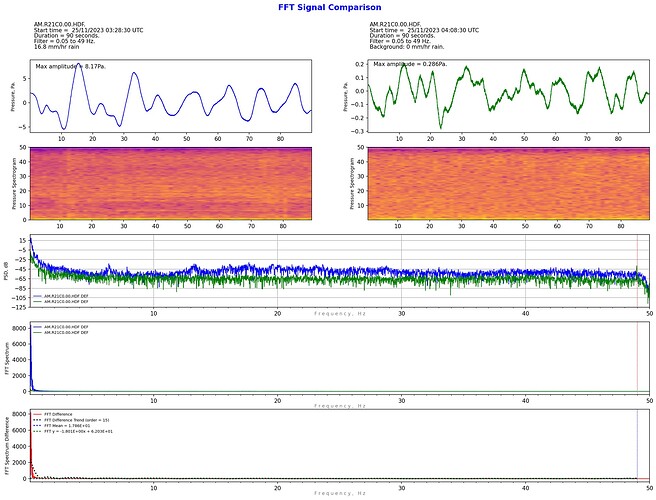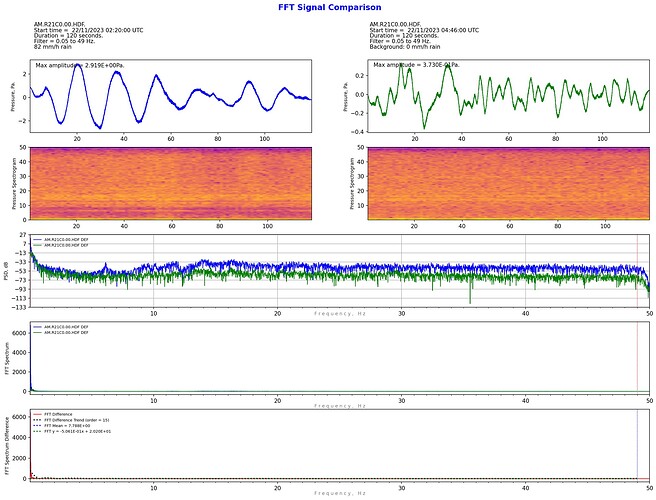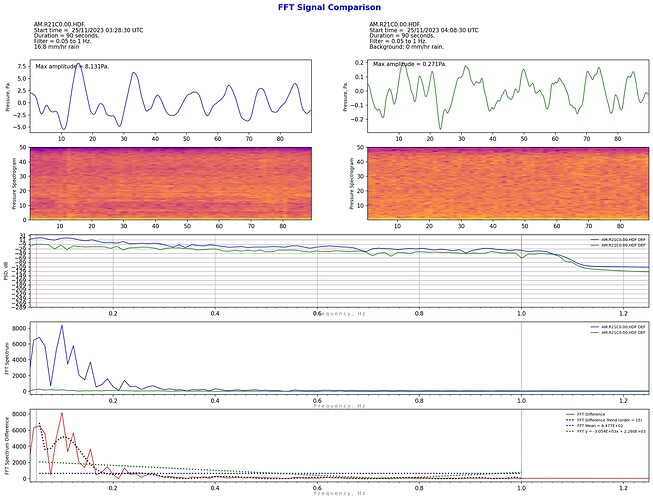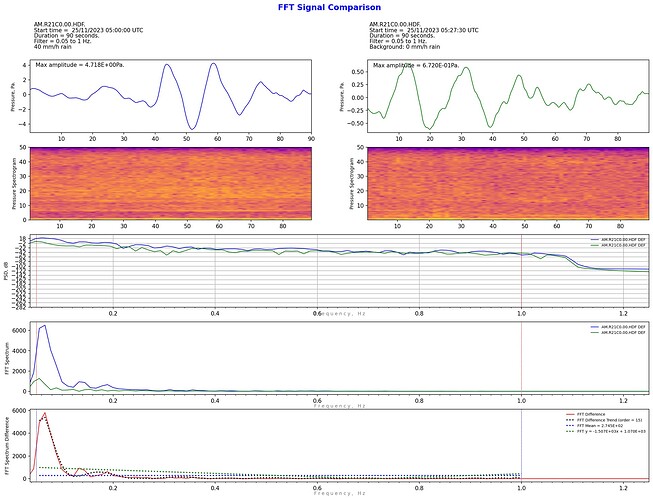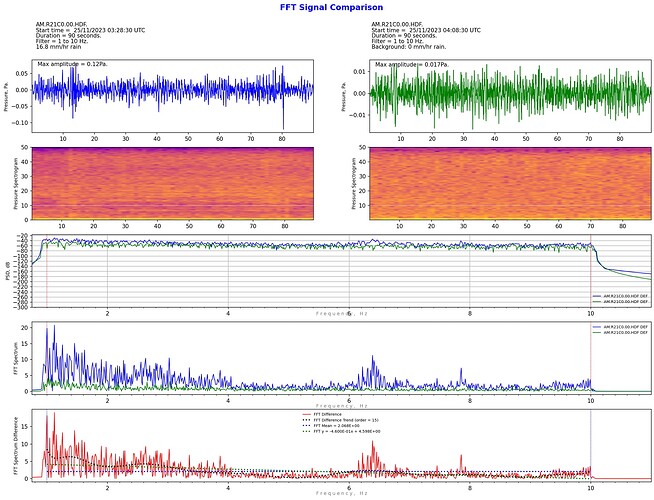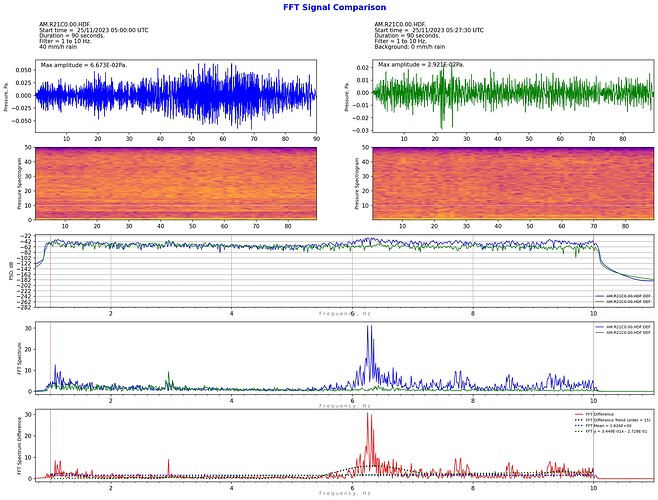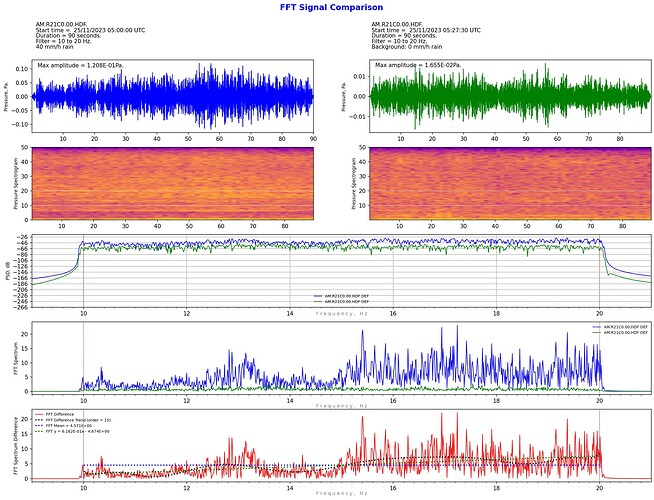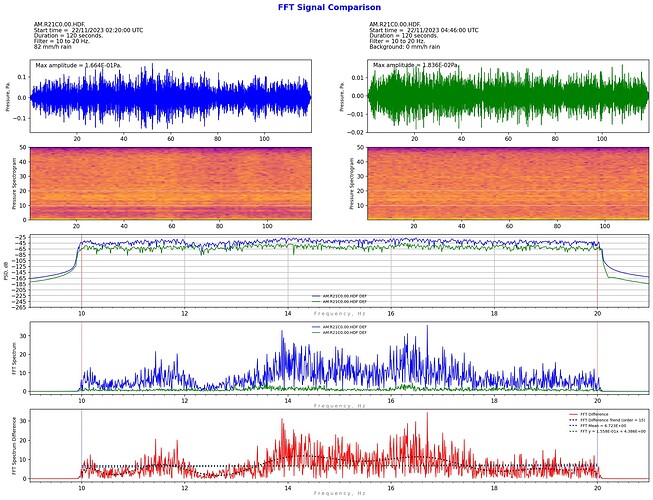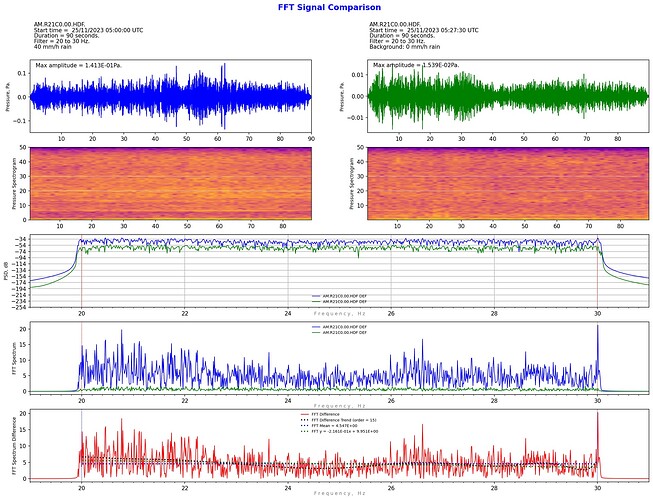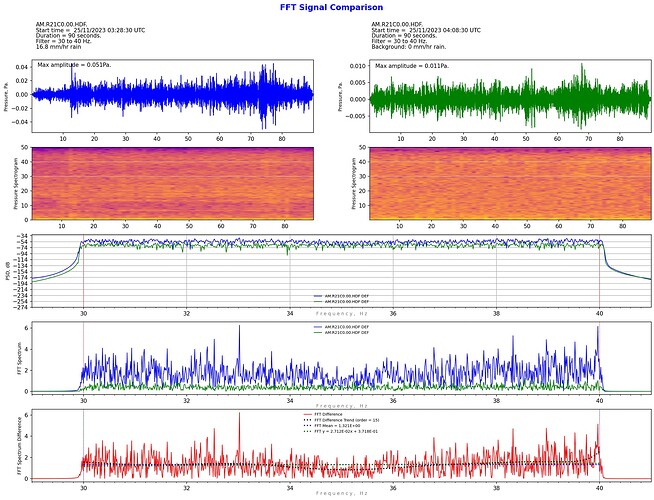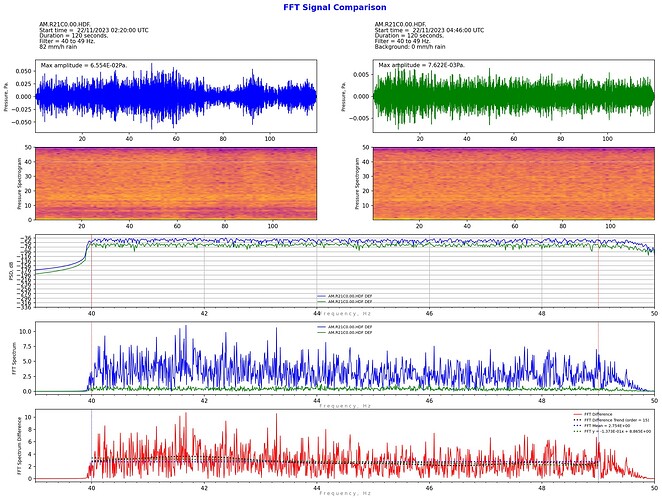The following are the results of some experiments I did with my Shake and Boom to determine the characteristic infrasound signature of rain (if there is one). From experience it is likely the signature for rain would be broad band white noise or similar i.e. nearly uniform signal strength at all frequencies, maybe with some bias applied.
For the experiment, I chose three rain periods during recent showers with different rain rates. I also chose three background noise periods near to these to compare and subtract the FTT spectrums to remove any common noise frequencies. Think of this as like subtracting a dark frame from a photo to remove any hot pixels.
As my Shake and Boom (R21C0) is fitted with the 20s mechanical filter, I’ve chosen 0.05Hz (P=20s) as my lowest bandpass frequency.
The broadband (0.05 to 49Hz) results are as follows:
Comparing waveform amplitudes:
Signal Background
16.8 mm/h 8.17 Pa 0.286 Pa
40 mm/h 4.86 Pa 0.686 Pa
82 mm/h 2.9 Pa 0.373 Pa
This result was not expected. Intuitively heavy rain sounds louder, so I was expecting the waveform amplitudes to increase with increasing rain rate, but obviously the opposite is true for broadband infrasound in the range of 0.05 to 49 Hz.
My hypothesis to explain this is that the rain itself is absorbing frequencies in this range in the same way that the water sprays used during rocket launches absorb the sound from the rocket engines to reduce the noise levels to safe/non-damaging levels.
Comparing the PSD Plots:
Firstly, from about 10Hz upwards, the rain signal is pretty uniformly higher than the background. This fits with the intuitive notion that the sound of rain is basically white noise.
Secondly, both background and rain signals rise at the very low end of the spectrum (<2 Hz).
The third characteristic evident in the PSDs is a peak in the rain signal at about 6 Hz. I have no hypothesis for why this is. It may be a characteristic of my installation/house, for example, responding to the rain.
To keep results comparable with other Booms, I chose to analyse the very low frequencies (<1 Hz) in their own bandpass filter. This allows booms with 20s filters to compare these frequencies, and all Booms to compare frequencies > 1Hz.
Comparing the waveform amplitudes for 0.05 to 1 Hz:
Signal Background
16.8 mm/h 8.131 Pa 0.271 Pa
40 mm/h 4.718 Pa 0.672 Pa
82 mm/h 2.797 Pa 0.353 Pa
Clearly the bulk of the infrasound energy is in this very low range (0.05 to 1 Hz).
The amplitudes in this frequency range also reduce with increasing rain rate, so these frequencies appear to be absorbed by the rain itself.
Comparing the FFT plots:
Peak infrasound appears to be 0.06Hz, and the height of the peak decreases with increasing rain rate.
There is a second leak at about 0.1 Hz on the 16.8 mm/h FFT plot. Perhaps this peak is more readily absorbed by the droplets so is fully absorbed at higher rain rates. More tests at lower rain rates would be needed to test this hypothesis.
The background signal for 40mm/h rain rate also shows a definite bump of lower amplitude at 0.06 Hz. There is also a slight bump at 0.06 Hz in the background FFT for 82 mm/h rain rate. Given the complete lack of a bump at 16.8 mm/h rain rate, it is possible these bumps are due to the rain shower still being nearby enough to transmit the infrasound despite the rain being passed.
In the 1 to 10Hz range, the signal trends down from 1Hz to about 4Hz, and decreases in amplitude with increasing rain rate.
The peak at around 6.1 to 6.4 Hz is maximum at 40 mm/hr rain rate, and small peaks that appear in the 40 mm/h rain rate signal seem to merge into a broad peak around 9.4 Hz at 82mm/h rain rate.
In the 10 to 20 Hz range, it appears the amplitude increases with increasing rain rate. So, these frequencies are not absorbed by the rain drops.
In the 20 to 30Hz range, the amplitude increases from 16.8 mm/h to 40 mm/h but 40mm/h and 82mm/h are much the same. Hard to draw a conclusion or formulate a hypothesis from that sort of trend with so little data.
From 30 Hz and up the FFT spectrum settle down to be pretty flat and like the 20 to 30 Hz range seem to increase from 16.8 mm/h to 40 mm/h, but not much increase from 40 mm/h to 82mm/h.
Summary:
The characteristic infrasound signature for rain would appear to be:
- A dominant frequency around 0.06 Hz which decreases in amplitude with increasing rain rate.
- A broadband (white noise) increase from about 10 Hz up.
- Weak signal between 2 and 10 Hz on FFT spectrogram. Some peaks may be evident in this range.
- Amplitude increasing with rain rate for frequencies in the range of 10 to 20Hz.
- Amplitude constant or increasing with increasing rain rate for f >30Hz.
Surely this must get me honourary membership in the dull men’s club! ;o)
Al.
